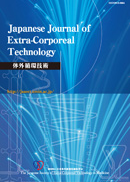
- Issue 4 Pages 377-
- Issue 2 Pages 119-
- |<
- <
- 1
- >
- >|
-
Koichi Kashiwa, Hideo Kurosawa, Mai Takahashi, Sayaka Koga, Haruka Asa ...2019Volume 46Issue 4 Pages 377-381
Published: 2019
Released on J-STAGE: December 20, 2019
JOURNAL FREE ACCESSThis survey targeted 128 patients with approved implantable ventricular assist devices (iVADs) in Japan implanted from April 2011 to September 2017, and 330 caregivers that were trained on the handling of iVADs. We looked into the outcomes of tests for handling their wearing iVADs.
We then studied the relationship between the results of device handling tests and the trail making test-B (TMT-B) performed for patients;3 and/or 6 months after implanting iVADs. The data was analyzed by Fisher’s exact test, with p<0.05 considered statistically significant.
The number (rate) of patients who required re-testing for competency more than 3 times was for EVAHEART®, DuraHeart®, HeartMate II ®, Jarvik2000®;0, 0, 4, 3 (0, 0, 8.7, 10.0%), respectively. Also, the rate of caregivers who required re-testing for competency more than 3 time was 0, 0, 5.8, 11.3%, respectively. The relationship between the results of the device handling test and the trail making test-B (TMT-B) was considered statistically significant (p=0.002), the sensitivity and specificity were 29.1, 95.5%, respectively. These results may suggest the possibility that training on the handling of iVADs can be efficiently conducted in reference to the outcome of TMT-B. However, the frequency of the device test required tends to depend on the types of iVADs that the patient receives. Our previous study showed that there was an association between the types of devices and the incidence rate of mistakes. Therefore, we strongly feel the importance of adapting fool proof and/or fault tolerant in designing the devices, thereby improving the usability for efficient training on the handling of iVADs.
View full abstractDownload PDF (545K) -
-- Definition factors of the roller pump occlusion on stable the roller pump operation --Shota Kato, Yoshimasa Kusama, Kaoru Abe, Takashi Shibamoto2019Volume 46Issue 4 Pages 382-387
Published: 2019
Released on J-STAGE: December 20, 2019
JOURNAL FREE ACCESSIn our country, a centrifugal pump is chosen by the open-heart surgery that have gave top priority to safety and biocompatibility. However, in the foreign countries, the open-heart surgery using the roller pump increases in consideration of operability and economy. The roller pump occlusion paid attention to the long-time operation causing axis displacement; Our study carried out that perfusion temperature executed the technology as a rule factor of the occlusion.
To evaluate the manifestation of the circumference of the occlusion, we used three kinds of different rollers diameter and measured perfusion temperature (Pt) and the electrical resistivity (Rz:resistance sigma), a pressure degree of the occlusion. Based on JIS-T1603, we observed the changed to kinds of the three pumps with degree of the occlusion which we were setting in the same condition as change of the occlusion by the progress at time. Pt and Rz repeated up-down motion in three pumps every 30-60 minutes. In addition, the occlusion extended the interval in progress at time. The pressure level of the sensor rose every 30 minutes and became unmeasurable afterwards.
This phenomenon affects is that perfusion temperature changes influence the blood viscosity and, we suppose that it influenced a rise in para-blood temperature and it appeared in pressure change and Rz of the occlusion. Therefore, control of the Pt leads to the appropriate control of the roller pump and thinks with an indispensable element though we carry out physiological extracorporeal.
View full abstractDownload PDF (1374K)
-
Yuichi Nishimura, Daigo Tokudome, Naomasa Terada, Takeru Sasaki, Hidek ...2019Volume 46Issue 4 Pages 388-392
Published: 2019
Released on J-STAGE: December 20, 2019
JOURNAL FREE ACCESS
- |<
- <
- 1
- >
- >|